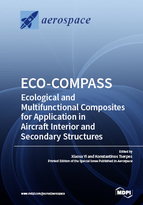ECO-COMPASS: Ecological and Multifunctional Composites for Application in Aircraft Interior and Secondary Structures
A special issue of Aerospace (ISSN 2226-4310).
Deadline for manuscript submissions: closed (31 August 2018) | Viewed by 80011
Special Issue Editors
2. AVIC Composite Corporation Ltd. (ACC), Beijing 100000, China
Interests: structural composites; polymer materials; functional composites; process engineering; materials modeling and green composites
Interests: computational and experimental strength of materials; advanced composites; nanocomposites; adhesives; nanocryctalline materials; multi-scale modeling; bio-based polymers and bio-composites; shock wave mechanics; structural health monitoring; recycling of composites; life-cycle analysis
Special Issues, Collections and Topics in MDPI journals
Special Issue Information
Dear Colleagues,
Today, mainly man-made materials, such as carbon and glass fibers, are used to produce composite parts in aviation. Renewable materials, such as natural fibers or bio-sourced resin systems, have not yet found their way into aviation. The project ECO-COMPASS aims to evaluate the potential applications of ecologically improved composite materials in the aviation sector in an international collaboration of Chinese and European partners. Natural fibers like flax and ramie will be used for different types of reinforcements and sandwich cores. Furthermore, bio-based epoxy resins to substitute bisphenol-A based epoxy resins in secondary structures are under investigation. Adapted material protection technologies to reduce environmental influence and to improve fire resistance are needed to fulfil the demanding safety requirements in aviation. Modelling and simulation of chosen eco-composites aims for an optimized use of materials while a Life Cycle Assessment aims to prove the ecological advantages compared to synthetic state-of-the-art materials. This Special Issue will provide selected papers from the project consortium partners.
This Special Issue is cooperating with the special session entitled “ECO-COMPASS: Ecological and Multifunctional Composites for Application in Aircraft Interior and Secondary Structures” that was organized at ICCS20 (Paris, France, 4–7 September 2017, https://events.unibo.it/iccs20). It will give the opportunity to present research activities carried out within the project and to disseminate recent results and achievements.
Authors of outstanding papers related to the ECO-COMPASS project are invited to submit their work to this Special Issue for publication.
Prof. Dr. Xiaosu YiProf. Dr. Konstantinos Tserpes
Guest Editors
Manuscript Submission Information
Manuscripts should be submitted online at www.mdpi.com by registering and logging in to this website. Once you are registered, click here to go to the submission form. Manuscripts can be submitted until the deadline. All submissions that pass pre-check are peer-reviewed. Accepted papers will be published continuously in the journal (as soon as accepted) and will be listed together on the special issue website. Research articles, review articles as well as short communications are invited. For planned papers, a title and short abstract (about 100 words) can be sent to the Editorial Office for announcement on this website.
Submitted manuscripts should not have been published previously, nor be under consideration for publication elsewhere (except conference proceedings papers). All manuscripts are thoroughly refereed through a single-blind peer-review process. A guide for authors and other relevant information for submission of manuscripts is available on the Instructions for Authors page. Aerospace is an international peer-reviewed open access monthly journal published by MDPI.
Please visit the Instructions for Authors page before submitting a manuscript. The Article Processing Charge (APC) for publication in this open access journal is 2400 CHF (Swiss Francs). Submitted papers should be well formatted and use good English. Authors may use MDPI's English editing service prior to publication or during author revisions.
Keywords
- bio-composite
- eco-composite
- bio-fibre
- bio-resin
- multifunction green composites
- characterization
- modelling and simulation
- applications
- life cycle assessment
- aviation







